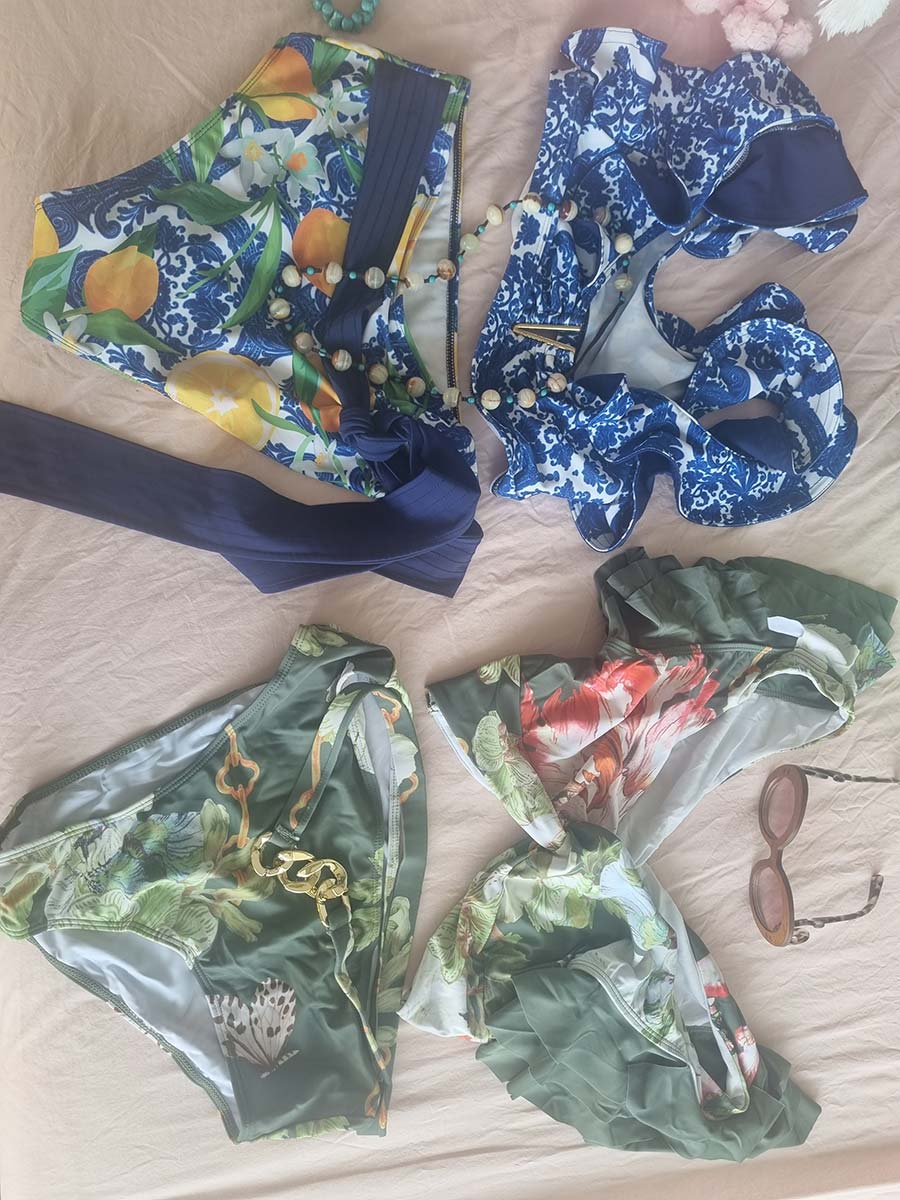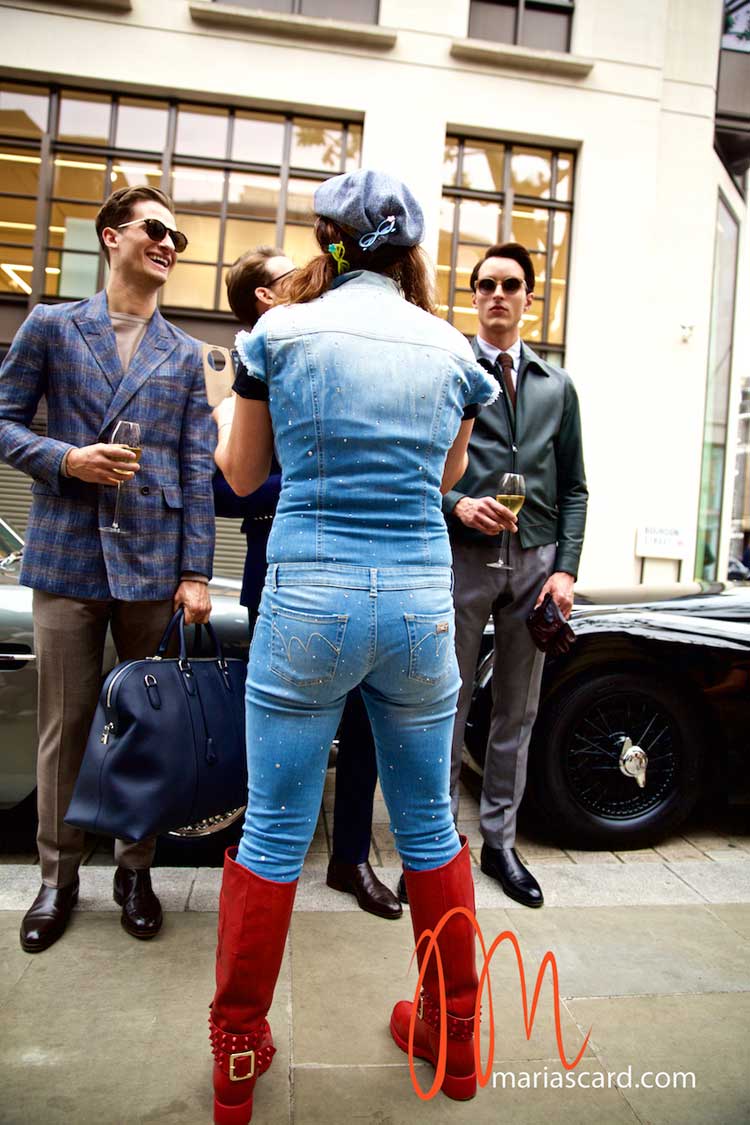As I lounge in the tropical paradise of Koh Samui, Thailand, my thoughts meander from the crystal-clear waters to a topic that’s as passionate to me as a perfectly tailored Dolce & Gabbana suit: fashion. But not just any fashion. I’m talking about the dizzying whirlwind of fast fashion and the glaring contrast between how the world treats our clothes versus our cars. Picture this: me, sipping on a mango smoothie, my eyes wandering over to a scene from “The White Lotus” being filmed nearby, pondering over the lavish and opulent lifestyle we all adore, yet wondering why the fashion industry seems to skate on thin ice when it comes to environmental accountability.
So, what’s the moral of this tale? It’s a call to action, a reminder that every choice we make—from the clothes we buy to the brands we support—has an impact. It’s about recognizing that true luxury lies not in the quantity of our possessions but in their quality and the ethics behind their creation. As someone who adores the finer things in life, I believe it’s possible to indulge in fashion’s delights while still honoring our planet and its inhabitants.
United Kingdom
In the heart of the UK, a country celebrated for its unrivaled creative talent and historic contributions to the global fashion scene, lies an opportunity to transform an industry at a crossroads. The fashion sector, a vibrant tapestry woven with innovation and elegance, faces a dual challenge: the pressing cost-of-living crisis and the looming shadow of the climate crisis. Addressing these issues isn’t just necessary; it’s an opportunity to redefine what fashion stands for in the 21st century.
Let’s tackle the elephant in the room—the cost-of-living crisis. It’s a harsh reality that many in the UK are grappling with, as the gap between wages and living expenses widens. In these trying times, fashion remains a beacon of self-expression and personal joy. However, the irony is as thick as a winter coat: the iconic British fashion that we adore and take pride in often comes with price tags that are out of reach for many.
The alternative? Fast fashion. Affordable, yes, but at what cost?
Here’s where the plot thickens: fast fashion is not just about affordability; it’s a major player in the climate crisis. The numbers speak volumes. According to a report by McKinsey, the fast fashion industry’s relentless production cycle results in a staggering amount of waste—imagine three out of every five garments ending up as landfill fodder or going up in smoke, quite literally. This isn’t just an environmental debacle; it’s a heart-wrenching waste of creativity and resources.
KPMG’s research sheds light on a hopeful statistic: two-thirds of UK consumers are eco-conscious, eager to align their purchasing decisions with their environmental values. Yet, here lies the conundrum. The very structure of the fashion industry, with its intricate web of supply chains and traditional business models, seems to trap us in a vortex of unsustainable choices. Are we doomed to choose between our wallets and our world?
The Solution
The answer is a resounding no. The solution? A two-pronged approach that requires us to not only reimagine but revolutionize the very foundations of the fashion industry. First, we must untangle and reconstruct the supply chains and business models that currently dictate the rhythm of production. This isn’t about minor adjustments or superficial greenwashing efforts; it’s about a deep, systemic transformation that aligns with both ethical standards and environmental sustainability.
Second, and most exhilarating, is tapping into the UK’s most abundant and vibrant resource: its creative talent. The UK’s ascent to the zenith of the global fashion industry was not by chance but by the sheer force of its creativity.
It’s time to harness this creative energy once again, not just to design beautiful garments but to lead the charge in sustainable fashion innovation.
Imagine a fashion industry where sustainability isn’t an afterthought but the cornerstone of every collection. Where designers and brands draw on the UK’s rich heritage of innovation to craft garments that tell a new story—one of respect for our planet and its inhabitants. This is not a distant dream; it’s an achievable reality. But it requires courage, commitment, and a collective effort from all stakeholders in the fashion ecosystem.
As consumers, we wield more power than we realize. Our choices can drive change, encouraging brands to prioritize sustainability over speed. As designers and industry leaders, the onus is on us to pave the way for a fashion revolution that marries style with sustainability.
In the face of these daunting challenges, the UK’s fashion industry stands at a crossroads. Down one path lies the status quo, a world of fleeting trends and forgotten wastes. Down the other, a future where fashion not only looks good but does good. It’s a choice between temporary convenience and long-term sustainability, between immediate gratification and the well-being of future generations.
The journey ahead is not without its hurdles, but with the UK’s legendary creative talent at the helm, there’s every reason to believe in a brighter, greener fashion future. Let’s seize this moment to redefine what fashion means in the modern world, crafting a legacy that we can all be proud of—one stitch, one garment, one choice at a time.
Reviewing Electric Cars
Why, you ask? Well, let’s dive into the ruffled, sequined depths of this enigma. I’ve been blogging about fashion since 2011, swooning over vintage finds and the exquisite quality of Italian fabrics. Recently, my love affair with luxury cars took a sharp turn towards 2025, when I started reviewing them, too. From the electric hum of a Tesla in the bustling streets of London to the sleek silence of an Audi, the automotive industry has been under the microscope, with governments and environmentalists alike pushing for a cleaner, greener future. Electric vehicles are the new black, darling, and cities like London and Oxfordshire are setting the runway for a zero-emission future, with speed limits that would make a snail smirk.

But here’s where the plot thickens: amidst the clamor for electric cars and smart cities, the fashion industry, a notorious polluter, struts down the global runway with barely a slap on the wrist. Brands like Boohoo, Shein, Zara, H&M, and Primark churn out fast fashion faster than a gossip spreads in a small town, with murky supply chains and practices that would make your grandma’s pearls clutch themselves in horror.
Why, oh why, in this age of environmental enlightenment, are the likes of D&G, Gucci, and Dior not being held to the same standards as Ferrari, which is now, begrudgingly or not, embracing electric models?
It’s like comparing apples and organically grown, ethically sourced avocados. The car industry is being steered (pun intended) towards sustainability, while fashion giants continue to produce mountains of unsold clothes, destined for the landfill, the sea, or worse, the incinerator, without so much as a stern look from those in power.

Shein China
Ah, Shein. Now, there’s a name that whizzes around the world of fast fashion with the speed and agility of an Aston Martin Vantage leaving everyone else in the dust. Let’s talk about this phenomenon, shall we? As I pen this from my sunny retreat, the juxtaposition couldn’t be starker: the beauty and tranquility of nature around me versus the whirlwind pace and ethical conundrums of fast fashion.

Shein, my darlings, has become somewhat of a global behemoth in the realm of fast fashion, churning out clothing at a pace that makes even the most seasoned fashionistas do a double take. With a model that seems to defy the traditional rules of retail, they’ve captured the hearts and wallets of many, offering a dizzying array of styles at prices that often seem too good to be true. And perhaps, in a way, they are.
Now, the elephant in the room or should I say, the unwelcome guest at our opulent garden party—is the whispers and rumors about child labor.

These allegations cast a long, unflattering shadow over Shein’s sparkly facade. It’s a topic that turns the glitzy, glamorous world of fashion into something far more murky and complex.
It’s disheartening, to say the least, to hear such claims. Fashion, with its power to express and transform, should be a force for good, not a source of exploitation. It’s a reminder that behind every impossibly cheap garment is a story, and sometimes, those stories are not what we’d hope.
As for Greta, our young climate change warrior, it seems the fast fashion juggernaut is barreling down the highway without a glance in the rearview mirror at environmental concerns. The industry’s carbon footprint is enormous, with waste and pollution that contradict everything Greta and so many of us stand for. Yet, the machine thunders on, fueled by insatiable demand and an endless cycle of trends.
In producing clothing faster than a luxury sports car’s takeoff, there’s a stark reminder of the cost of convenience. It’s not just the environment that pays the price but also potentially the welfare of workers, hidden away from the glossy advertisements and flashy websites.
Last Week France’s National assembly, passed a bill that steep tax bills will now be applied to fast fashion brands that damage the environment. It is called a sin tax and up to 10euro per item sold will be charged, but it’s goes into effect in 2030! It is a start but more needs to be done.
Fashion Weeks Must Stop
And let’s not forget about the runways of London, Paris, Milan, and New York. These glittering events showcase the crème de la crème of fashion, yet behind the glam and the glitz lies an uncomfortable truth: a significant portion of these clothes will never feel the warmth of a spotlight or the adoration of an audience. They’re the unsung victims of fast fashion’s relentless pace.
Now, I’m not saying we should all ditch our wardrobes and don sackcloth. Far from it! I live for fashion, for the feel of silk against my skin, and the jingle of a well-chosen accessory.
What I am advocating for is a bit of common sense and a dollop of accountability.
If we can lust after electric cars and praise the innovators driving us towards a cleaner automotive future, why can’t we demand the same from the fashion industry?
Why is it that when I scroll through Lazada here in Southeast Asia, I’m bombarded with knock-offs and cheap imitations that wouldn’t last a season, let alone a lifetime? These products not only devalue the craftsmanship of genuine designers but also contribute to the ever-growing problem of waste and pollution.

Greta Thunberg No Fashion?
In a world where Greta Thunberg takes aim at celebrities and their private jets, one has to wonder why the fashion industry isn’t also in her crosshairs. Fast fashion, with its relentless production of garments destined never to be worn, is still thriving in 2024. It’s a paradox that leaves me baffled, my dear readers.
As I watch another scene from “The White Lotus” unfold, I can’t help but draw parallels between the scripted dramas and the real-life saga of fashion vs. sustainability.
It’s a tale of two industries: one, forced to clean up its act under the watchful eye of the world, and the other, seemingly untouchable, continuing to weave a tapestry of waste and exploitation.
But, as I always say, hope is the thing with feathers—or in this case, perhaps, a well-cut blazer. Change is possible, and it starts with us. By embracing slow fashion, supporting ethical brands, and demanding transparency and sustainability from our favorite labels, we can make a difference. It’s time for the fashion industry to step up and take responsibility, just as the car industry has been compelled to do.
So, here’s to a future where fashion and sustainability walk hand in hand down the runway, where luxury doesn’t come at the cost of our planet, and where every piece of clothing we don our fabulous selves with is as green as it is glamorous. Until then, I’ll be here, in my little corner of Koh Samui, dreaming of a world where the clothes we love love our Earth in return. Cheers to that, darlings!
But here’s the kicker, my fashion-forward friends: we are part of this narrative. Our choices, our clicks, our purchases—they all play a role in this grand production. It’s easy to point fingers at the brands, but change, real change, starts with us. It’s about making more conscious decisions, questioning where our clothes come from, and deciding whether we want to be part of a system that values speed and cost over everything else.
Imagine, if you will, a world where fashion slows down just a tad. Where quality trumps quantity, where sustainability is the norm, and where every piece of clothing has a story we can be proud of. It’s not just a dream; it’s a possibility, and it starts with us.
So, as I gaze out at the serene beauty of Koh Samui, I can’t help but dream of a better, kinder fashion world. One where companies like Shein take a moment to look at the beautiful world around them and decide to shift gears towards a more sustainable and ethical approach. It might seem like a tall order, but hey, every grand journey begins with a single, stylish step.
Until then, I’ll be here, living my best life, advocating for a world where fashion and responsibility go hand in hand. It’s a beautiful dream, and one worth striving for. Cheers to that, darlings!















You must be logged in to post a comment.